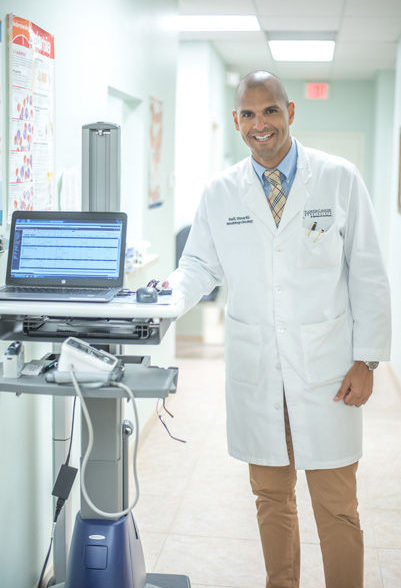
In the not-too-distant past, according to Vero Beach oncologist Dr. Raul Storey, a diagnosis of leukemia was all-to-often a de facto death sentence.
Today, things have changed. Radically. For the better.
There are over a dozen different types of leukemia (sometimes called “cancer of the blood” or “blood cell cancer”), with four strains predominating in frequency and in lethality.
The Cleveland Clinic says, “Leukemia often is considered a disease of children, yet it actually affects far more adults. In fact, the frequency of the disease increases with age.”
The National Cancer Center adds that, “Leukemia occurs most often in adults older than 55 years.”
In a highly capsulized description, leukemia is cancer of the body’s blood-forming tissues, especially the bone marrow and the lymphatic system. Unlike other cancers, leukemia does not produce tumors. Instead it causes an overproduction of abnormal blood cells in general and white blood cells in particular.
“The white cells,” explains Storey, “are responsible for fighting infection. However, the abnormal cells in leukemia do not function the same way as normal white blood cells, making the patient more prone to infections.”
The gregarious Storey, whose Florida Cancer Specialists and Research Institute boasts a five-star patient satisfaction rating from WebMD, leans forward and continues: “The leukemia cells continue to grow and divide, eventually crowding out the normal blood cells. The end result is that it becomes difficult for the body to fight infections, control bleeding and transport oxygen. White blood cells are the most common type of blood cell to become cancerous. But red blood cells or cells that carry oxygen from the lungs to the rest of the body and platelets – the cells that clot the blood – may also become cancerous.”
Of the four most common and lethal forms of leukemia – acute lymphocytic leukemia, chronic lymphocytic leukemia, acute myeloid leukemia and chronic myeloid leukemia – Storey says chronic lymphocytic leukemia or CLL, and chronic myeloid leukemia or CML are “the most common ones I see in Vero Beach.”
Just those two types of leukemia account for upwards of 22,000 new cases in this country each year and the four most common forms of the disease combine for more than 40,000 new leukemia diagnoses annually.
Storey doesn’t flinch at those numbers. “In the old days,” he says, “the word leukemia was equal to a death sentence but not anymore. Today there are types of leukemia that we treat with [just] pills.”
“With the standard of care we have nowadays, we can use chemotherapy [including] targeted therapy, which means medications can go straight into the cancer cells and kill them. We can use genetic medication that can go and attack the genetic mutations that produce the leukemia and we can use immunotherapy. We can also use bone marrow transplants.”
Determining the type and the extent of the leukemia weighed against the age and overall health of the patient typically determines the course of treatment, but Storey emphatically adds that educating his patients is his most important task.
A good example is the anti-CML drug “Gleevec.” First approved by the FDA in 2001, the drug is known to have side-effects, including a possible link to heart problems. Storey says educating his patients about potential problems from drugs such as Gleevec, and thoroughly informing them about what to watch out for and how to report any possible adverse reactions is absolutely vital.
“All treatments have side-effects,” he adds. “We oncologists, we’re not afraid of side-effects because we know what the other option is.”
Leukemia is not easy for the layman to detect. Symptoms may include fevers, night sweats, swollen lymph nodes, fatigue, frequent infections or bone and joint pain. All of which, Storey freely admits, “can occur with multiple different conditions.”
Blood tests are generally the most effective way of diagnosing the disease and if a primary care physician spots something suspicious, he or she will likely refer the patient to an oncology and hematology expert like Storey.
In the meantime, there are scores of clinical trials currently underway nationwide searching for newer and better leukemia treatments. The New England Journal of Medicine last year published results from one promising study on “adoptive cell transfer” or ACT.
ACT, it says, “Has brought prolonged remissions to a high proportion of patients who were facing death from advanced leukemia after standard treatments had failed.” After six months, 23 of 30 study patients are still alive and 19 have experienced complete remissions of their leukemia.
News like that clearly fuels Storey’s passion for what he does but his own involvement with cancer started even before he got his medical degree.
“When I was in high school,” recalls the tall, lanky oncologist, “My dad got diagnosed with prostate cancer so I got involved with cancer well before getting involved in medicine. That was the beginning of my career in oncology.”
Dr. Raul Storey is with Florida Cancer Specialists & Research Institute at 1880 37th Street, Suite 101 in Vero and 13060 U.S. Hwy. One, Suite A in Sebastian. The Vero phone number is 772-567-2332. In Sebastian it’s 772-589-0879.



